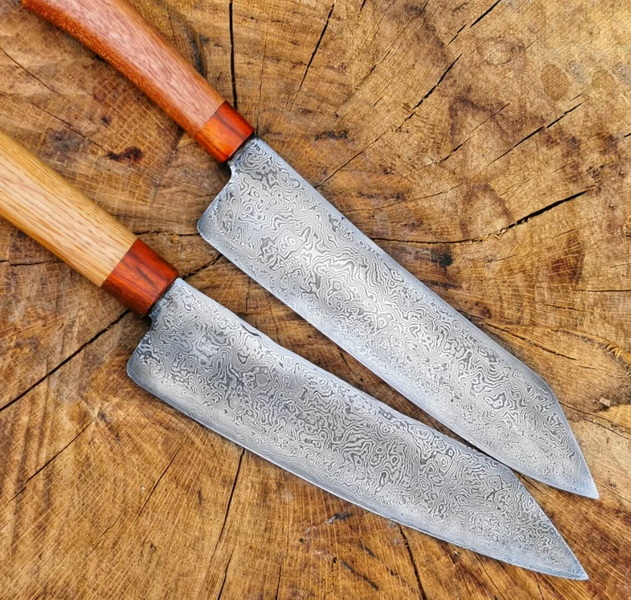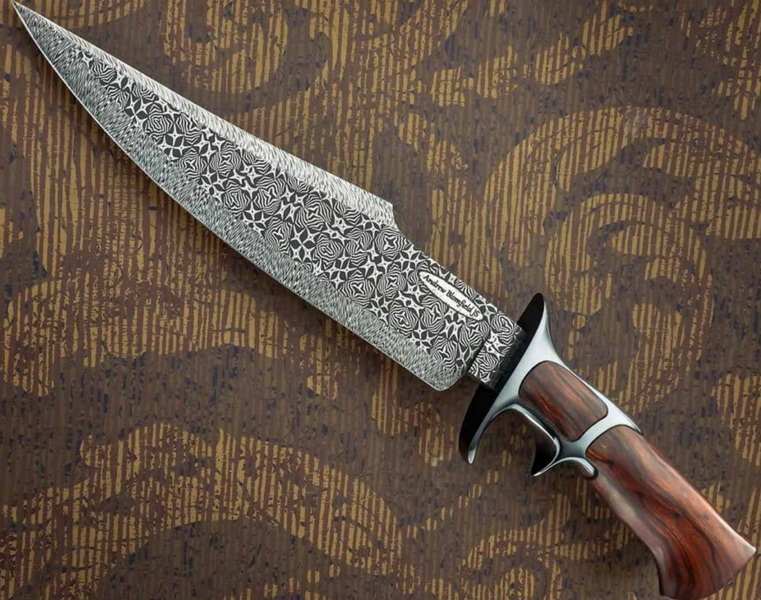- All
- Product Name
- Product Keyword
- Product Model
- Product Summary
- Product Description
- Multi Field Search
Views: 222 Author: Ann Publish Time: 2025-10-19 Origin: Site











Content Menu
● Additional detailed steps of forging involve:
● Advantages of Damascus Knives for Custom Projects
>> Superior Edge Retention and Sharpness
>> Exceptional Strength and Flexibility
>> Rust and Corrosion Resistance
● Maintenance Tips for Damascus Knives
● OEM Custom Knife Manufacturing Benefits
>> 1. What makes Damascus knives different from regular stainless steel knives?
>> 2. How is the pattern on a Damascus blade created?
>> 3. Are Damascus knives difficult to maintain?
>> 4. Can Damascus blades be made for kitchen knives?
>> 5. Does OEM production affect quality?
When it comes to crafting exquisite and high-performance knives, Damascus steel stands out as a premier choice for custom knife makers and enthusiasts alike. Known for its strikingly beautiful layered patterns and exceptional functional qualities, Damascus steel brings together craftsmanship, heritage, and modern metallurgy in a way few other materials can.This is the Damascus knife.

Damascus steel refers to a type of steel that is forged through a process of layering and folding different types of steel, typically combining high and low carbon content. This layered forging technique creates characteristic flowing patterns on the blade surface that are not just decorative, but indicate a blade with enhanced strength, sharpness, and flexibility.
Many modern Damascus knives are made by stacking steel billets, heating, folding, and forging repeatedly to produce a weld of several hundred layers, resulting in a blade with both hardness and resilience.
The forging method behind Damascus steel is inherently artistic and technical. To produce a Damascus knife:
1. Multiple layers of steels with different carbon contents are stacked.
2. The stack (billet) is heated to a high temperature, typically over 1500°F.
3. It is hammered and folded repeatedly, which welds the layers together and helps distribute carbon evenly.
This process is time-consuming but crucial for the blade's final strength and beauty. Artisan blacksmiths use specialized techniques to create distinct patterns, often folding the steel multiple times until hundreds of layers form.
- Cutting steel plates of alternating high and low carbon steels into identically sized layers.
- Stacking and aligning these layers carefully before heating.
- Heating the billet in a furnace at about 1500–2000°F to achieve welding temperature.
- Hammering and folding the billet repeatedly (sometimes up to eight or more folds) to multiply layers while refining the microstructure.
- Quenching and tempering the blade through multiple cycles to relieve stresses and optimize hardness and toughness.
- Acid etching the blade to reveal the characteristic contrasting pattern.
The combination of hard and soft layers enables Damascus knives to hold an extremely sharp edge for longer periods while allowing easier re-sharpening compared to single-steel blades.
The layered steel construction prevents brittleness by balancing hardness and ductility. The softer layers provide flexibility, helping resist chipping and cracking even under demanding use.
Each Damascus knife is unique due to its hand-forged patterns, which vary with blade design and folding technique. This uniqueness is highly prized for custom knife buyers seeking one-of-a-kind pieces.
Many modern Damascus knives blend stainless steel variants that boost corrosion resistance, making them practical for kitchen and outdoor use.
Damascus steel is suitable for various knife types, including chef knives, hunting knives, and collector's pieces. OEM manufacturers benefit from its adaptability, creating knives that meet diverse client specifications and preferences.
Heat treatment elevates Damascus steel knives from raw forged steel to finished masterpieces. Thermal cycling involves heating the blade to non-magnetic temperature points and controlled quenching, then tempering at precise temperatures (generally around 350°F to 450°F). This process refines the grain structure and balances hardness with toughness, enhancing cutting performance and blade resilience.

Maintaining the beauty and performance of Damascus steel requires regular care:
- Clean with warm water and mild soap; avoid harsh chemicals.
- Dry immediately to prevent rust.
- Lightly oil the blade after cleaning to protect against corrosion.
- Store in a dry environment with a protective sheath.
- Sharpen with whetstones or professional systems to preserve the edge without damaging the layered pattern.
For factories providing OEM services, Damascus steel offers a compelling angle:
- It combines traditional craftsmanship with modern performance, helping brands differentiate products.
- The unique surface patterns allow for creative customization and branding opportunities.
- High-quality Damascus knives justify premium pricing, enhancing profit margins.
- The material's performance qualities meet demands for durable, sharp, and visually appealing knives.
- OEM manufacturers can cater to specialized markets, including culinary professionals, collectors, and outdoor enthusiasts.
The art of forging Damascus steel involves patience and precision. Each fold doubles the number of layers, with typical knives containing 256 or more layers after forging. The use of flux such as borax prevents oxidation during heating. Some artisans add elements like nickel or manganese in the steel mix to produce sharper contrasts in the final blade pattern. The forging is often done manually with hydraulic or air hammers, followed by belt grinding to shape and refine the blade profile.
A notable phase is the final acid etching, using ferric chloride or vinegar solutions, which chemically highlights the varying steel layers, turning the blade surface into a living artwork. This etching must be timed precisely to avoid over-etching and loss of fine detail.
Damascus steel is an exceptional material for custom knife projects, blending historical forging traditions with contemporary metallurgical advances. Its unique layered construction delivers superior cutting performance, durability, and unmistakable beauty. For OEM manufacturers, Damascus steel knives represent an opportunity to produce distinctive, high-quality products that stand out in competitive global markets. Proper handling, heat treatment, and finishing all contribute to the final excellence of the knife, making Damascus knives a prized possession for chefs, collectors, and outdoor enthusiasts alike.

Damascus knives are crafted by layering and forging multiple steels together, resulting in visually distinct patterns and a blade that balances hardness with flexibility, unlike single-steel blades.
The pattern emerges from repeated folding and welding of alternating steel layers, revealed by acid etching that contrasts the different metals.
They require routine cleaning, drying, and oiling but are not significantly harder to care for than other quality knives.
Yes, Damascus steel is popular for chef and kitchen knives due to its sharpness, resilience, and aesthetic appeal.
OEM Damascus knives maintain quality when skilled craftsmanship, proper materials, and precise forging and heat treatment processes are followed.
The Ultimate Professional Knives for Halal Butchery in Middle Eastern Kitchens
Chef Knife Size Guide: Choosing Between 6″, 8″, 10″, And 12″
Custom Knife Handles: How To Design A Chef Knife That Fits Your Hand Perfectly
Chef Knife Surface Treatments Guide: From Polished Migaki To Damascus Patterns
Inside Our Professional Knife Sample Room: Quality You Can See
Universal Knife Block Buying Guide: Modern Acrylic & ABS Knife Holders for Professional Kitchens
Universal Knife Block: The Complete Guide To Modern, Hygienic Knife Storage
The Complete Guide To Red Handle Knife Sets: Style Meets Functionality in The Kitchen
Professional Knives for Halal Butchery And Middle Eastern Cuisine